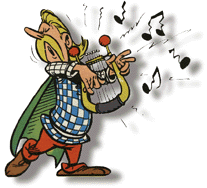|
In December of 2000, at the 140th meeting of the Acoustical Society of America in Newport Beach, CA, I presented a paper entitled: "Musical Instruments of Antiquity as Illustrated in The Adventures of Asterix the Gaul." This is by far one of the most enjoyable papers I have ever presented at a professional society meeting, though I'll admit, I was a bit unsure of how it was going to be received at the time. I still remember the unsure look in the eyes of the session chair as he introduced me and the title of my paper - as if he was wondering what kind of weirdness was about to follow. Fortuitously, my paper was scheduled at the end of a very interesting, though serious, afternoon session on the acoustics of historical brass instruments. In spite of the fact that this meeting was held California (most Americans know nothing of Asterix), many acousticians in the audience were from Europe and Australia and so were familiar enough with the Asterix comic books that they understood the jokes and humor. My paper ended up going over very well, elicited much laughter from the audience, and brought the session to an enjoyable conclusion
This was such a fun project that I found myself wishing I could make it a bit more permanent than just an abstract in conference proceedings. I am a huge fan of the Asterix comic books and movies and, with my graduate school training in the physics of musical instruments, this topic seemed to be something I just had to pursue for pure fun and enjoyment. It is now several years later, and I've finally found the time to put a thoroughly expanded version of my paper online as a webpage article. Of course, I realize that a large part of what made the original presentation work so well was the fact that it was an oral presentation and that I had the ability to carry out a serious discussion of a musical instrument while the screen behind me was displaying a humerous cartoon image of that instrument - something which cannot be replicated in print. But, if you should find yourself reading this, and exploring further through the links below, I hope you enjoy what you find. For any musical historians who read this article, this emphasis of this paper was humor more than historical fact, and while I did do some research into the real historical uses of the musical instruments descirbed below, I'd be happy to learn of any errors from those who know better.  drussell@engr.psu.edu drussell@engr.psu.edu
|


 drussell@engr.psu.edu
drussell@engr.psu.edu